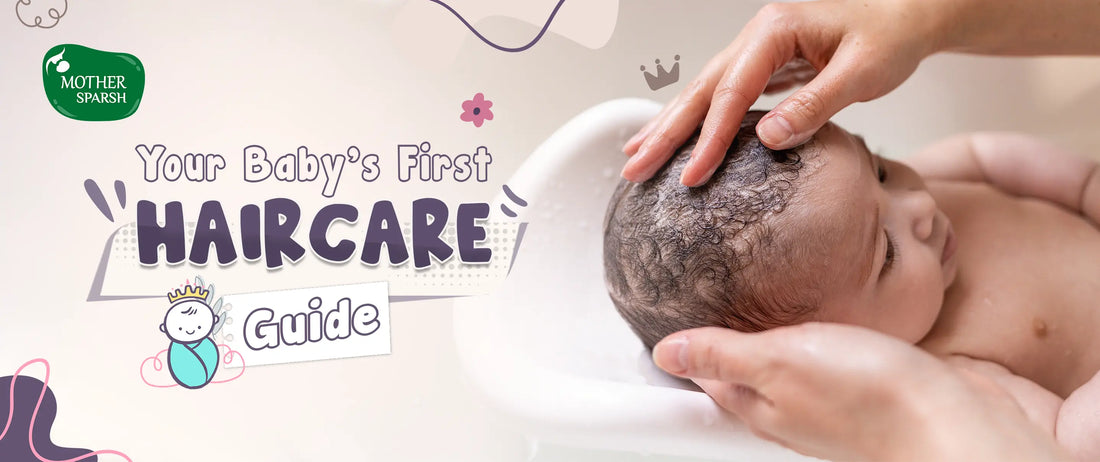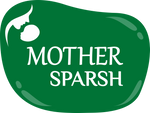
Your Baby’s First Haircare Guide: Cradle Cap, Dry Scalp and Gentle Shampooing
You’ve mastered swaddling, learned how to burp like a pro and survived countless diaper changes. But then one day, as you run your fingers through your little one’s soft hair or scalp, you notice flakes. Instantly, you panic - Is this cradle cap? Dry scalp? Do I need to wash more? Or less?
Here’s what you need to know: both cradle cap and dry scalp are incredibly common in babies and most of the time, they’re nothing to worry about. With a little know-how and gentle care, you can keep your baby’s scalp healthy and comfortable, without stress.
Table of Contents
Understanding Baby’s Scalp: What’s Normal and What’s Not
Baby’s skin is far more delicate than ours, which means even small changes like dry air or overactive oil glands can show up quickly on their scalp.
-
Cradle cap looks like thick, greasy, yellow or brownish scales that stick to the skin. It might look alarming, but it usually doesn’t bother your baby at all.
-
Dry scalp, on the other hand, appears as fine, loose, white flakes. The skin may look a little red and in some cases, baby may seem itchy or uncomfortable.
The most important thing to know? You’re not doing anything wrong. Neither condition is caused by poor hygiene. In fact, washing too often can make things worse.
Cradle Cap: The Flaky Little Frenemy
Cradle cap is the most common scalp condition in babies. Doctors believe it’s caused by overactive oil glands stimulated by mom’s hormones during pregnancy. The result is thick, scaly patches that stick to the scalp (and sometimes eyebrows).
What to do:
-
Gently massage the scalp with a soft baby brush to loosen flakes.
-
Apply a light baby-safe oil (like coconut or almond) before shampooing, to soften patches.
-
Wash with a gentle shampoo to cleanse without irritation.
The good news? Cradle cap usually clears up on its own by 6–12 months.
Dry Scalp: Gentle Care for Sensitive Skin
Dry scalp can show up any time, especially in colder months or if baby is bathed too often. Unlike cradle cap, the flakes are finer and looser.
What to do:
-
Limit bath time to 5–10 minutes.
-
Avoid very hot water.
-
Use a humidifier in baby’s room to add moisture to dry air.
-
Switch to a moisturizing shampoo designed for babies.
Think of dry scalp as your baby’s way of saying, “Hey, I need a little extra hydration here!”
Gentle Shampooing: Less Is More
When it comes to baby haircare, less is always more. You don’t need to shampoo every day; 2–3 times a week is usually enough unless your baby’s hair gets dirty from spit-up or sweat.
Here’s how to wash a baby’s hair gently:
-
Wet scalp with lukewarm water.
-
Use a coin-sized amount of baby shampoo.
-
Massage in softly with fingertips (no hard scrubbing).
-
Rinse thoroughly and pat dry with a soft towel.
Parent Tip: Choose a shampoo that not only cleans but also nourishes. Mother Sparsh Daily Moisturizing Milky Soft Baby Shampoo is a great option. Here’s why parents love it:
-
Tear-free formula → gently cleanses hair and scalp without stinging eyes, so bath time stays calm and fuss-free.
-
Enriched with Milk and Coconut extracts → provides natural nourishment to keep the scalp soft and healthy.
-
Locks in moisture → ideal for little ones dealing with dryness or cradle cap flakes.
With this kind of shampoo, bath time becomes more than just cleaning; it’s a comforting bonding moment for both of you.
And what to avoid:
-
Harsh scrubbing irritates delicate skin.
-
Adult dandruff shampoos are far too strong for babies.
-
Essential oils directly on a newborn's scalp may cause reactions.
When to Call the Pediatrician
Most cases of cradle cap and dry scalp are harmless, but call your pediatrician if you notice:
-
Red, inflamed or painful-looking patches.
-
Bleeding or oozing skin.
-
Flakes spreading beyond the scalp (to face or body).
Remember, doctors see this all the time, so don’t hesitate to ask for help if you’re unsure.
Conclusion: Keep It Simple, Keep It Gentle
Here’s the thing: your baby doesn’t need a perfect scalp. A little flake here or there is part of the journey. What matters most is keeping your routine simple, gentle and filled with love. And baby haircare doesn’t have to be complicated. Whether it’s cradle cap or dry scalp, always remember to:
-
Identify the condition.
-
Be gentle in your approach.
-
Use a nourishing, tear-free shampoo like Mother Sparsh Daily Moisturizing Milky Soft Baby Shampoo to keep scalp and hair soft.
Because in the end, haircare isn’t just about flakes, it’s about comfort, closeness and showing your little one that every detail of their care matters.




